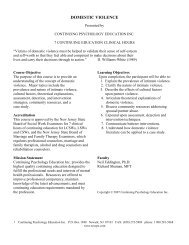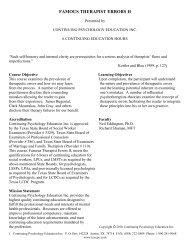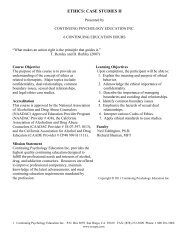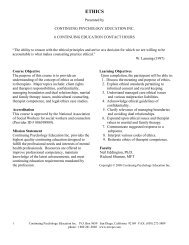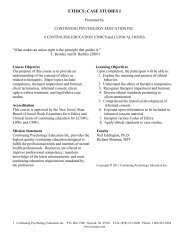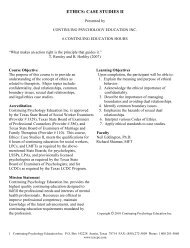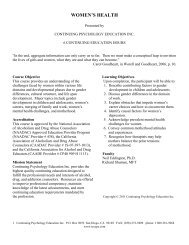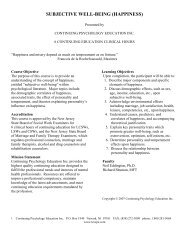FAMOUS THERAPIST ERRORS - Continuing Psychology Education
FAMOUS THERAPIST ERRORS - Continuing Psychology Education
FAMOUS THERAPIST ERRORS - Continuing Psychology Education
Create successful ePaper yourself
Turn your PDF publications into a flip-book with our unique Google optimized e-Paper software.
<strong>FAMOUS</strong> <strong>THERAPIST</strong> <strong>ERRORS</strong>of themselves as lacking some sort of power that the therapisthas.”In the above case, Pittman admitted that his mistake wasplaying for the audience instead of responding to the family’sneeds. In such settings, there can be a conflict of interest inthe needs of therapist and client, specifically, “If you aredoing therapy right, it’s not very showy. It’s very warm, it isvery comforting, yet at the same time it is quite confrontive.You put new information into the system but it does notmake a spectacular show and it doesn’t wow a crowd. Whenyou try to make it a great show, you run the risk of alienatingthe people you are trying to help.” On a positive note,Pittman deduced that client left the session knowing whatwas expected of him and that there was at least one otherperson who believed he had the ability to do it. Therapistadmitted to not knowing client’s outcome because manyvariables are involved that are out of therapist’s control;Pittman addressed this issue by saying, “I try my hardest notto take responsibility for things over which I have no control– that would really paralyze me as a therapist.”Counselors may work with people in pain and anguish, butPittman cautions practitioners to remain objective, otherwise,we could feel as bad and become as paralyzed as they maybe. “We have to be there in the midst of that pain whilekeeping ourselves sufficiently out of it. We have to maintainour ability to have hope, our ability to do reality testing. It’svery hard work.”Relieving client pain is one goal for therapists, but Pittmanbelieves that within this honorable intention therapy errorsmay be concealed, in turn, he suggests vigilance and alsocognizance that sometimes we must inflict pain byenlightening clients that they are doing something wrong andthat they can do things differently. Despite his vigilance,Pittman disclosed that “In every interview I am hittingsomething too hard or not hard enough. I’m hitting thewrong thing or my reality testing is faulty, but even then mycaring comes through, and more importantly, my optimismfor change.”When asked how he would like others to perceive him,Pittman modestly said, “I’ve been around about as long asanyone in family therapy. Because I have been doing privatepractice most of that time, and because I am rather a terminalworkaholic, I’ve done a lot of family therapy. I figuredrecently I had logged more than 75,000 hours. And I’m stillnot doing it right.”SAM GLADDINGGladding has written some of the major texts in thecounseling field, including Community and AgencyCounseling; The Counseling Dictionary; Counseling: AComprehensive Profession; Family Therapy: History Theory,and Practice; Group Work: A Counseling Specialty; Ethical,Legal, Professional Issues in the Practice of Marriage andFamily Therapy; and Becoming a Counselor: The Light, theBright, and the Serious. In 1999, he was cited as being in thetop 1% of authors in the counseling field. He has been acounseling professor at Wake Forest University, and he hasbeen President of the American Counseling Association andthe Association for Counselor <strong>Education</strong> and Supervision.Ineffective therapy, to Gladding, is when therapist or clientexhibits less than desirable behavior culminating in a badsituation, or therapist says or does something that does notsucceed.This counselor described a personal therapy failureconcerning a middle-aged woman presenting with the issueof being nervous all the time. Therapist tried to help herrelax allowing exploration into the issue but she actuallybecame more agitated and ultimately ran out of the office.He tried systematic desensitization, deep breathing,attempted to work through her irrational thinking, and askedclient to try meditation but the situation simply worsened.In evaluating his performance, Gladding assessed that hedid not prepare client well enough for the treatmentmodalities, went too fast instead of letting her talk and thenbeing reflective, and he tried to fix her rather than allowingher to ventilate feelings. Counselor reflected, “Maybe Ishould have been more self-disclosing and personal with her,especially about my own nervousness. I certainly shouldhave reflected her feelings more often and stayed with herexperience. Maybe that would have been more appropriateinstead of going with a ‘Let’s see if I can help you relax’ kindof response.”Gladding felt bad because client walked out on himresulting in no closure so he never learned what happened toher. He learned to sense when to go slowly with a client asindicated by his evaluation, “I thought here is a situation thatis maybe teaching me that there is much more to human lifethan what I thought I knew. Instead of addressing matters asquickly as I had before, I’ve been more cautious and morehumble in working with people.”This case reminded Gladding that one must be prepared forthe unexpected even when presenting issues appear simpleand predictable. A potential hazard for veteran counselors isto treat new cases as if they are familiar because ourassumptions can distort the unfolding of actual events.Gladding believes that therapists must be lifelong learners, infact, “It’s being somebody who’s constantly trying tounderstand the human condition. It is about realizing thatpeople sometimes don’t fit our theories.”When asked why counselors are reluctant to divulge theirtherapy failures, Gladding mentioned two factors: therapistsare trained to uphold confidentiality so we do not disclose allevents occurring during a session, and admitting mistakes cancause us to lose some status. Further, there may be evenmore to lose for well-known practitioners who have attaineda certain status in the field – these individuals may havesuperhuman expectations leading to belief in their ownmyths.Gladding admitted that he had experienced other badtherapy cases but the one he shared simply haunted him morethan the others. A concluding analysis by Gladding led himto say, “I think that bad experiences in therapy are like grainsof sand in oysters. At first, they are really irritating. They11 <strong>Continuing</strong> <strong>Psychology</strong> <strong>Education</strong> Inc.



